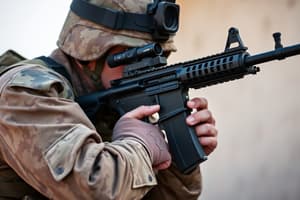Podcast
Questions and Answers
The size of the average parking area is 2.5m x 5m for ______ parking.
The size of the average parking area is 2.5m x 5m for ______ parking.
perpendicular or diagonal
2.15m x 6m is required for ______ parking.
2.15m x 6m is required for ______ parking.
parallel
The parking size for an Articulated Truck with a 12.0m container is ______ x 18.0m.
The parking size for an Articulated Truck with a 12.0m container is ______ x 18.0m.
3.6m
______ parking requires a size of 3.0m x 9.0m.
______ parking requires a size of 3.0m x 9.0m.
Truck or bus parking shall have a minimum of ______ x 12m.
Truck or bus parking shall have a minimum of ______ x 12m.
An Elevator is a hoisting and lowering mechanism equipped with a car or platform which moves in guides in a ______ direction.
An Elevator is a hoisting and lowering mechanism equipped with a car or platform which moves in guides in a ______ direction.
An Elevator serves two or more ______ of a building or structure.
An Elevator serves two or more ______ of a building or structure.
An Elevator is an enclosed cab fastened to one end of ______ cables.
An Elevator is an enclosed cab fastened to one end of ______ cables.
The cables travel up and over a grooved drive ______.
The cables travel up and over a grooved drive ______.
A counterweight of cast iron blocks that counterbalance the weight of the ______.
A counterweight of cast iron blocks that counterbalance the weight of the ______.
The machine room-less elevator uses new gearless 'permanent magnet' (PM) ______ technology.
The machine room-less elevator uses new gearless 'permanent magnet' (PM) ______ technology.
Machine room-less elevators are generally good for a ______ to ______ story range.
Machine room-less elevators are generally good for a ______ to ______ story range.
Conventional elevators have a rooftop ______.
Conventional elevators have a rooftop ______.
Machine room-less elevators take up less space and have less weight due to the absence of a ______.
Machine room-less elevators take up less space and have less weight due to the absence of a ______.
Some load limits exist, with problems occurring with heavy loads greater than ______ lbs.
Some load limits exist, with problems occurring with heavy loads greater than ______ lbs.
Dumbwaiters are small lifts installed in kitchens for transferring cooked hot food, dirty utensils, _____ materials.
Dumbwaiters are small lifts installed in kitchens for transferring cooked hot food, dirty utensils, _____ materials.
Dumbwaiters for kitchens are usually made of _____ steel.
Dumbwaiters for kitchens are usually made of _____ steel.
The capacity starts from _____ kgs onwards as desired.
The capacity starts from _____ kgs onwards as desired.
Only about _____ extra space is required in the building to fit this lift.
Only about _____ extra space is required in the building to fit this lift.
The entrance can be protected by either a swing window or vertical _____ doors.
The entrance can be protected by either a swing window or vertical _____ doors.
According to the ordinance, 1-15 slots require _____ PWD Slots.
According to the ordinance, 1-15 slots require _____ PWD Slots.
More than 15 slots require _____ PWD Slots.
More than 15 slots require _____ PWD Slots.
Public assembly buildings require 1 slot for every ______m² of the spectator area.
Public assembly buildings require 1 slot for every ______m² of the spectator area.
The Persons with Disabilities Special Parking Privilege Ordinance was established in _____ year.
The Persons with Disabilities Special Parking Privilege Ordinance was established in _____ year.
City Ordinance No. 11 pertains to _____ parking privileges.
City Ordinance No. 11 pertains to _____ parking privileges.
Elementary schools require 1 slot for every ______ classrooms.
Elementary schools require 1 slot for every ______ classrooms.
Colleges and universities need 1 slot for every ______ classrooms.
Colleges and universities need 1 slot for every ______ classrooms.
Ordinance No. 11 aims to provide _____ for persons with disabilities.
Ordinance No. 11 aims to provide _____ for persons with disabilities.
Hospitals require 1 slot for every ______ beds.
Hospitals require 1 slot for every ______ beds.
Bowling alleys require 1 slot for every ______ alleys.
Bowling alleys require 1 slot for every ______ alleys.
The __________ stops the car and counterweight in case of emergency by actuating the Safety.
The __________ stops the car and counterweight in case of emergency by actuating the Safety.
The Safety device exerts retarding force in case of overspeed by gripping the __________.
The Safety device exerts retarding force in case of overspeed by gripping the __________.
Limit switches are automatic devices that stop the car within the __________.
Limit switches are automatic devices that stop the car within the __________.
The counterweight usually equals the weight of the car plus __________ of its capacity.
The counterweight usually equals the weight of the car plus __________ of its capacity.
A buffer is a device that absorbs the impact of the car or __________.
A buffer is a device that absorbs the impact of the car or __________.
Traction elevators use geared AC or DC motors with __________ for mid-rise buildings.
Traction elevators use geared AC or DC motors with __________ for mid-rise buildings.
Hydraulic elevators use a __________ to push the elevator up.
Hydraulic elevators use a __________ to push the elevator up.
The high-speed gearless systems use more expensive __________ motors.
The high-speed gearless systems use more expensive __________ motors.
The escalator is a moving staircase in which the steps move as a unit upward or downward at an incline of about _____ degrees.
The escalator is a moving staircase in which the steps move as a unit upward or downward at an incline of about _____ degrees.
The _____ is the motor that drives the handrail.
The _____ is the motor that drives the handrail.
The _____ are the chains that connect the steps to the sprockets.
The _____ are the chains that connect the steps to the sprockets.
The _____ keeps the steps on track.
The _____ keeps the steps on track.
The motor that powers the escalator is called the _____ motor.
The motor that powers the escalator is called the _____ motor.
The ______ is responsible for controlling the movement of the elevator.
The ______ is responsible for controlling the movement of the elevator.
The ______ provides the necessary lifting force for the elevator car.
The ______ provides the necessary lifting force for the elevator car.
The ______ helps ensure safe operation by monitoring the speed of the elevator.
The ______ helps ensure safe operation by monitoring the speed of the elevator.
The ______ helps balance the weight of the elevator car.
The ______ helps balance the weight of the elevator car.
The ______ is the part of the elevator that passengers enter.
The ______ is the part of the elevator that passengers enter.
The parking slot, parking area and loading/unloading space requirements are generally the minimum off-street cum on-site requirements for specific ______.
The parking slot, parking area and loading/unloading space requirements are generally the minimum off-street cum on-site requirements for specific ______.
All parking requirements must be located outside of the road right-of-way (______)
All parking requirements must be located outside of the road right-of-way (______)
According to Presidential Decree ______, these regulations apply to the National Building Code of the Philippines.
According to Presidential Decree ______, these regulations apply to the National Building Code of the Philippines.
The requirements listed in the decree apply to buildings and ______.
The requirements listed in the decree apply to buildings and ______.
Loading/unloading space requirements are part of the ______ area specifications.
Loading/unloading space requirements are part of the ______ area specifications.
Flashcards are hidden until you start studying
Study Notes
Parking Space Requirements
- Average parking space dimensions:
- Perpendicular/diagonal: 2.5m x 5m
- Parallel: 2.15m x 6m
- Articulated truck with a 12m container: 3.6m x 18.0m
- Jeepney: 3.0m x 9.0m
- Disabled parking: 3.7m x 5.0m
- Truck/bus parking: Minimum 3.6m x 12m
Elevator Overview
- Elevators function as hoisting and lowering devices, connecting multiple floors in buildings.
- Comprised of a car or platform suspended by steel cables, counterbalanced by a cast iron weight.
Machine Room-less Elevators
- Features latest technology with gearless “permanent magnet” systems.
- Motors mounted on guard rails, reducing space requirements.
- Best suited for low to mid-rise buildings (4-6 stories).
- Energy-efficient design limits heavy load capacities above 5000 lbs.
Conventional Elevators
- Typically include a rooftop machine room and a heavy geared machine system.
- Utilize a governor and conventional ropes with coated-steel belts for operation.
Elevator Safety Features
- Governor: Engages safety mechanisms to halt the car in emergencies.
- Safety Device: Installed in the cab frame, it slows the car in overspeed situations.
- Limit Switches: Automatically stop the car within limits, independent of the operating device.
- Counterweight: Balances the car weight, typically matching the car weight plus 40% of its capacity.
- Buffer: Absorbs impacts at the lower travel limits.
Lifting Mechanisms for Elevators
- Traction:
- Utilizes geared AC or DC motors suitable for buildings up to 1000 feet.
- High-speed systems may involve costly induction motors.
- Hydraulic:
- Economical solution for 2-7 story buildings.
- Employs pistons to elevate the car but carries risks of soil contamination from hydraulic fluid.
Dumbwaiters
- Small lifts designed for transporting food and utensils between floors in various settings.
- Made from stainless steel to withstand steam and hot food.
- Capacity begins at 20 kgs; dimensions range from 1.5' x 1.5' to 3' x 3' or larger.
- Requires minimal additional space for installation.
Escalators
- Moving staircases with steps inclined at approximately 30 degrees, powered electrically.
- Components include a handrail drive assembly, step chains, and sprockets.
- Elements ensure smooth operation and passenger safety.
Parking Slot Requirements for Various Buildings
- Public Assembly: 1 slot per 50m² of spectator area.
- Worship Places/Funerary Parlors: 1 slot per 50m² of congregation area.
- Schools: 1 slot per 10 classrooms (Elementary/Secondary) and 1 slot per 5 classrooms (Colleges).
- Hospitals: 1 slot per 25 beds.
- Bowling Alleys: 1 slot per 4 alleys.
Ordinance on Parking Privileges for Persons with Disabilities
- Specifies parking slot allocations based on total number of available slots:
- 1-15 slots: 1 PWD slot
- More than 15 slots: 2 PWD slots
Elevator Components
- Key components include control unit, electric motor, governor, hoist ropes, door opener, car, traveling cables, counterweight guide rails, counterweight, car guide rails, and car buffer.
Elevator Car Features
- Ceiling designs include various styles such as Arch, Crystal, and Mirage.
- Handrail options range from one to three railings.
- Various finishes available for COP and LOP, including colors like Anthracite Gray and Mint Green.
Studying That Suits You
Use AI to generate personalized quizzes and flashcards to suit your learning preferences.




